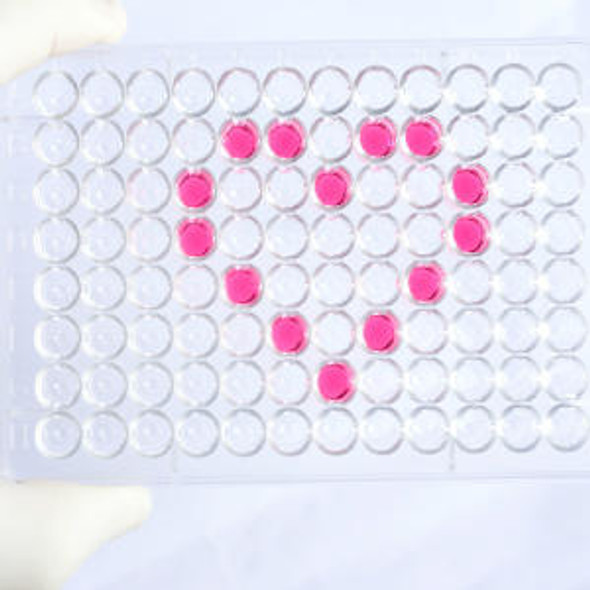Mouse Cellular tumor antigen p53 (Tp53) ELISA Kit
- SKU:
- MOEB0665
- Product Type:
- ELISA Kit
- Size:
- 96 Assays
- Uniprot:
- P02340
- ELISA Type:
- Sandwich
- Synonyms:
- TP53, BCC7, LFS1
- Reactivity:
- Mouse
Description
| Product Name: | Mouse Cellular tumor antigen p53 (Tp53) ELISA Kit |
| Product Code: | MOEB0665 |
| Alias: | Cellular tumor antigen p53, Tumor suppressor p53, Tp53, P53, Trp53 |
| Uniprot: | P02340 |
| Reactivity: | Mouse |
| Range: | Please contact us for more information |
| Detection Method: | Sandwich |
| Size: | 96 Assay |
| Storage: | Please see kit components below for exact storage details |
| Note: | For research use only |
| UniProt Protein Function: | p53: a transcription factor and major tumor suppressor that plays a major role in regulating cellular responses to DNA damage and other genomic aberrations. Activation of p53 can lead to either cell cycle arrest and DNA repair or apoptosis. More than 50 percent of human tumors contain a mutation or deletion of the TP53 gene. p53 is modified post-translationally at multiple sites. DNA damage induces phosphorylation of p53 at S15, S20 and S37, reducing its interaction with the oncoprotein MDM2. MDM2 inhibits p53 accumulation by targeting it for ubiquitination and proteasomal degradation. Phosphorylated by many kinases including Chk2 and Chk1 at S20, enhancing its tetramerization, stability and activity. The phosphorylation by CAK at S392 is increased in human tumors and has been reported to influence the growth suppressor function, DNA binding and transcriptional activation of p53. Phosphorylation of p53 at S46 regulates the ability of p53 to induce apoptosis. The acetylation of p53 appears to play a positive role in the accumulation of p53 during the stress response. Following DNA damage, p53 becomes acetylated at K382, enhancing its binding to DNA. Deacetylation of p53 can occur through interaction with SIRT1, a deacetylase that may be involved in cellular aging and the DNA damage response. p53 regulates the transcription of a set of genes encoding endosomal proteins that regulate endosomal functions. These include STEAP3 and CHMP4C, which enhance exosome production, and CAV1 and CHMP4C, which produce a more rapid endosomal clearance of the EGFR from the plasma membrane. DNA damage regulates a p53-mediated secretory pathway, increasing the secretion of some proteins such as Hsp90, SERPINE1, SERPINB5, NKEF-A, and CyPA, and inhibiting the secretion of others including CTSL and IGFBP-2. Two alternatively spliced human isoforms have been reported. Isoform 2 is expressed in quiescent lymphocytes. Seems to be non-functional. May be produced at very low levels due to a premature stop codon in the mRNA, leading to nonsense-mediated mRNA decay. |
| UniProt Protein Details: | Protein type:Tumor suppressor; Transcription factor; DNA-binding; Activator; Motility/polarity/chemotaxis; Nuclear receptor co-regulator Cellular Component: PML body; transcription factor TFIID complex; nuclear matrix; protein complex; mitochondrion; endoplasmic reticulum; replication fork; cytosol; nucleoplasm; nuclear body; transcription factor complex; mitochondrial matrix; nuclear chromatin; cytoplasm; nucleolus; intracellular; chromatin; nucleus Molecular Function:identical protein binding; protease binding; protein phosphatase 2A binding; metal ion binding; protein phosphatase binding; transcription factor binding; histone acetyltransferase binding; enzyme binding; sequence-specific DNA binding; double-stranded DNA binding; transcription factor activity; ATP binding; protein C-terminus binding; p53 binding; protein N-terminus binding; receptor tyrosine kinase binding; protein kinase binding; protein binding; histone deacetylase regulator activity; copper ion binding; DNA binding; protein heterodimerization activity; ubiquitin protein ligase binding; chaperone binding; damaged DNA binding; chromatin binding Biological Process: central nervous system development; positive regulation of apoptosis; regulation of cell cycle; positive regulation of leukocyte migration; positive regulation of transcription, DNA-dependent; multicellular organismal development; T cell differentiation in the thymus; programmed cell death; gastrulation; determination of adult life span; DNA damage response, signal transduction by p53 class mediator resulting in cell cycle arrest; regulation of apoptosis; cellular response to glucose starvation; protein localization; negative regulation of neuroblast proliferation; transforming growth factor beta receptor signaling pathway; regulation of neuron apoptosis; cerebellum development; protein complex assembly; negative regulation of mitotic cell cycle; cell cycle arrest; ER overload response; response to X-ray; response to UV; response to drug; release of cytochrome c from mitochondria; somitogenesis; transcription, DNA-dependent; chromatin assembly; positive regulation of cell cycle; cell aging; circadian behavior; rRNA transcription; regulation of transcription from RNA polymerase II promoter; positive regulation of peptidyl-tyrosine phosphorylation; negative regulation of DNA replication; negative regulation of fibroblast proliferation; regulation of intracellular pH; embryonic organ development; positive regulation of transcription from RNA polymerase II promoter; response to oxidative stress; negative regulation of transcription, DNA-dependent; regulation of tissue remodeling; negative regulation of apoptosis; transcription from RNA polymerase II promoter; G1 DNA damage checkpoint; DNA damage response, signal transduction by p53 class mediator; negative regulation of smooth muscle cell proliferation; apoptosis; negative regulation of transcription from RNA polymerase II promoter; chromosome organization and biogenesis; response to salt stress; entrainment of circadian clock by photoperiod; embryonic development ending in birth or egg hatching; positive regulation of protein oligomerization; negative regulation of cell proliferation; DNA damage response, signal transduction by p53 class mediator resulting in transcription of p21 class mediator; positive regulation of histone deacetylation; regulation of transcription, DNA-dependent; T cell proliferation during immune response; regulation of catalytic activity; double-strand break repair; positive regulation of neuron apoptosis; response to gamma radiation; DNA damage response, signal transduction by p53 class mediator resulting in induction of apoptosis; protein tetramerization; mitochondrial DNA repair; negative regulation of proteolysis; in utero embryonic development; B cell lineage commitment; multicellular organism growth; cell cycle; regulation of cell proliferation; T cell lineage commitment; neuron apoptosis; nucleotide-excision repair; protein import into nucleus, translocation; DNA strand renaturation; negative regulation of cell growth; negative regulation of transforming growth factor beta receptor signaling pathway; response to DNA damage stimulus |
| NCBI Summary: | This gene encodes tumor protein p53, which responds to diverse cellular stresses to regulate target genes that induce cell cycle arrest, apoptosis, senescence, DNA repair, or changes in metabolism. p53 protein is expressed at low level in normal cells and at a high level in a variety of transformed cell lines, where it's believed to contribute to transformation and malignancy. p53 is a DNA-binding protein containing transcription activation, DNA-binding, and oligomerization domains. It is postulated to bind to a p53-binding site and activate expression of downstream genes that inhibit growth and/or invasion, and thus function as a tumor suppressor. Mice deficient for this gene are developmentally normal but are susceptible to spontaneous tumors. Evidence to date shows that this gene contains one promoter, in contrast to alternative promoters of the human gene, and transcribes a few of splice variants which encode different isoforms, although the biological validity or the full-length nature of some variants has not been determined. [provided by RefSeq, Jul 2008] |
| UniProt Code: | P02340 |
| NCBI GenInfo Identifier: | 172047304 |
| NCBI Gene ID: | 22059 |
| NCBI Accession: | P02340.3 |
| UniProt Secondary Accession: | P02340,Q9QUP3, |
| UniProt Related Accession: | P02340 |
| Molecular Weight: | 393 |
| NCBI Full Name: | Cellular tumor antigen p53 |
| NCBI Synonym Full Names: | transformation related protein 53 |
| NCBI Official Symbol: | Trp53Â Â |
| NCBI Official Synonym Symbols: | bbl; bfy; bhy; p44; p53; Tp53Â Â |
| NCBI Protein Information: | cellular tumor antigen p53; tumor supressor p53; tumor suppressor p53; p53 cellular tumor antigen |
| UniProt Protein Name: | Cellular tumor antigen p53 |
| UniProt Synonym Protein Names: | Tumor suppressor p53 |
| Protein Family: | TP53-regulating kinase |
| UniProt Gene Name: | Tp53Â Â |
| UniProt Entry Name: | P53_MOUSE |
| Component | Quantity (96 Assays) | Storage |
| ELISA Microplate (Dismountable) | 8×12 strips | -20°C |
| Lyophilized Standard | 2 | -20°C |
| Sample Diluent | 20ml | -20°C |
| Assay Diluent A | 10mL | -20°C |
| Assay Diluent B | 10mL | -20°C |
| Detection Reagent A | 120µL | -20°C |
| Detection Reagent B | 120µL | -20°C |
| Wash Buffer | 30mL | 4°C |
| Substrate | 10mL | 4°C |
| Stop Solution | 10mL | 4°C |
| Plate Sealer | 5 | - |
Other materials and equipment required:
- Microplate reader with 450 nm wavelength filter
- Multichannel Pipette, Pipette, microcentrifuge tubes and disposable pipette tips
- Incubator
- Deionized or distilled water
- Absorbent paper
- Buffer resevoir
*Note: The below protocol is a sample protocol. Protocols are specific to each batch/lot. For the correct instructions please follow the protocol included in your kit.
Allow all reagents to reach room temperature (Please do not dissolve the reagents at 37°C directly). All the reagents should be mixed thoroughly by gently swirling before pipetting. Avoid foaming. Keep appropriate numbers of strips for 1 experiment and remove extra strips from microtiter plate. Removed strips should be resealed and stored at -20°C until the kits expiry date. Prepare all reagents, working standards and samples as directed in the previous sections. Please predict the concentration before assaying. If values for these are not within the range of the standard curve, users must determine the optimal sample dilutions for their experiments. We recommend running all samples in duplicate.
| Step | |
| 1. | Add Sample: Add 100µL of Standard, Blank, or Sample per well. The blank well is added with Sample diluent. Solutions are added to the bottom of micro ELISA plate well, avoid inside wall touching and foaming as possible. Mix it gently. Cover the plate with sealer we provided. Incubate for 120 minutes at 37°C. |
| 2. | Remove the liquid from each well, don't wash. Add 100µL of Detection Reagent A working solution to each well. Cover with the Plate sealer. Gently tap the plate to ensure thorough mixing. Incubate for 1 hour at 37°C. Note: if Detection Reagent A appears cloudy warm to room temperature until solution is uniform. |
| 3. | Aspirate each well and wash, repeating the process three times. Wash by filling each well with Wash Buffer (approximately 400µL) (a squirt bottle, multi-channel pipette,manifold dispenser or automated washer are needed). Complete removal of liquid at each step is essential. After the last wash, completely remove remaining Wash Buffer by aspirating or decanting. Invert the plate and pat it against thick clean absorbent paper. |
| 4. | Add 100µL of Detection Reagent B working solution to each well. Cover with the Plate sealer. Incubate for 60 minutes at 37°C. |
| 5. | Repeat the wash process for five times as conducted in step 3. |
| 6. | Add 90µL of Substrate Solution to each well. Cover with a new Plate sealer and incubate for 10-20 minutes at 37°C. Protect the plate from light. The reaction time can be shortened or extended according to the actual color change, but this should not exceed more than 30 minutes. When apparent gradient appears in standard wells, user should terminatethe reaction. |
| 7. | Add 50µL of Stop Solution to each well. If color change does not appear uniform, gently tap the plate to ensure thorough mixing. |
| 8. | Determine the optical density (OD value) of each well at once, using a micro-plate reader set to 450 nm. User should open the micro-plate reader in advance, preheat the instrument, and set the testing parameters. |
| 9. | After experiment, store all reagents according to the specified storage temperature respectively until their expiry. |
When carrying out an ELISA assay it is important to prepare your samples in order to achieve the best possible results. Below we have a list of procedures for the preparation of samples for different sample types.
| Sample Type | Protocol |
| Serum | If using serum separator tubes, allow samples to clot for 30 minutes at room temperature. Centrifuge for 10 minutes at 1,000x g. Collect the serum fraction and assay promptly or aliquot and store the samples at -80°C. Avoid multiple freeze-thaw cycles. If serum separator tubes are not being used, allow samples to clot overnight at 2-8°C. Centrifuge for 10 minutes at 1,000x g. Remove serum and assay promptly or aliquot and store the samples at -80°C. Avoid multiple freeze-thaw cycles. |
| Plasma | Collect plasma using EDTA or heparin as an anticoagulant. Centrifuge samples at 4°C for 15 mins at 1000 × g within 30 mins of collection. Collect the plasma fraction and assay promptly or aliquot and store the samples at -80°C. Avoid multiple freeze-thaw cycles. Note: Over haemolysed samples are not suitable for use with this kit. |
| Urine & Cerebrospinal Fluid | Collect the urine (mid-stream) in a sterile container, centrifuge for 20 mins at 2000-3000 rpm. Remove supernatant and assay immediately. If any precipitation is detected, repeat the centrifugation step. A similar protocol can be used for cerebrospinal fluid. |
| Cell culture supernatant | Collect the cell culture media by pipette, followed by centrifugation at 4°C for 20 mins at 1500 rpm. Collect the clear supernatant and assay immediately. |
| Cell lysates | Solubilize cells in lysis buffer and allow to sit on ice for 30 minutes. Centrifuge tubes at 14,000 x g for 5 minutes to remove insoluble material. Aliquot the supernatant into a new tube and discard the remaining whole cell extract. Quantify total protein concentration using a total protein assay. Assay immediately or aliquot and store at ≤ -20 °C. |
| Tissue homogenates | The preparation of tissue homogenates will vary depending upon tissue type. Rinse tissue with 1X PBS to remove excess blood & homogenize in 20ml of 1X PBS (including protease inhibitors) and store overnight at ≤ -20°C. Two freeze-thaw cycles are required to break the cell membranes. To further disrupt the cell membranes you can sonicate the samples. Centrifuge homogenates for 5 mins at 5000xg. Remove the supernatant and assay immediately or aliquot and store at -20°C or -80°C. |
| Tissue lysates | Rinse tissue with PBS, cut into 1-2 mm pieces, and homogenize with a tissue homogenizer in PBS. Add an equal volume of RIPA buffer containing protease inhibitors and lyse tissues at room temperature for 30 minutes with gentle agitation. Centrifuge to remove debris. Quantify total protein concentration using a total protein assay. Assay immediately or aliquot and store at ≤ -20 °C. |
| Breast Milk | Collect milk samples and centrifuge at 10,000 x g for 60 min at 4°C. Aliquot the supernatant and assay. For long term use, store samples at -80°C. Minimize freeze/thaw cycles. |










